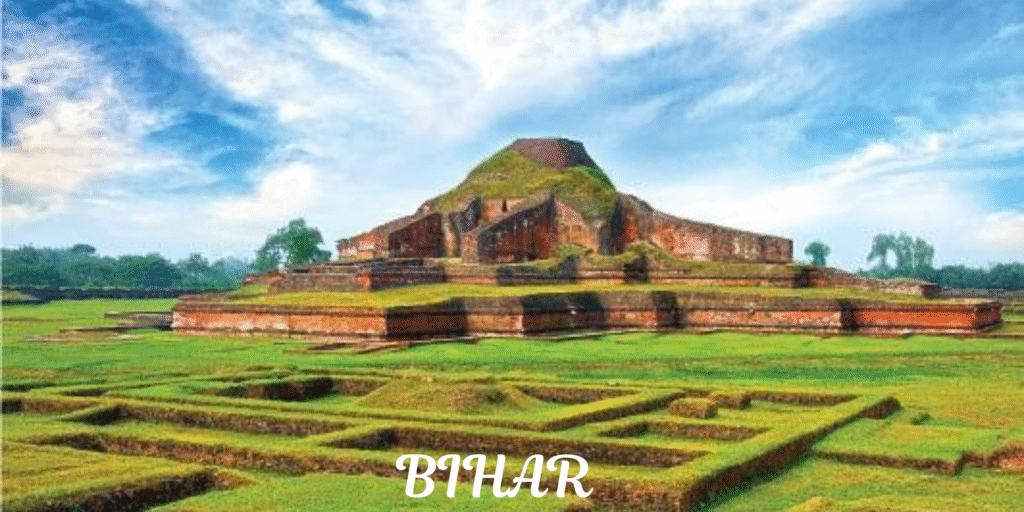
Why Visit Bihar?
Bihar isn’t just a state — it’s the cradle of Indian civilization. From the enlightenment of Buddha under the Bodhi Tree to the rise of mighty empires like Mauryas and Guptas, Bihar is soaked in history, layered with faith, and alive with stories that shaped the subcontinent.
Modern-day Bihar welcomes those who travel deeper — to rediscover roots, heritage, spirituality, and the rhythms of real, rural India.
Top Destinations in Bihar
Bodh Gaya – The Land of Enlightenment
Where Siddhartha became Buddha, under the sacred Bodhi Tree
Visit Mahabodhi Temple (UNESCO World Heritage Site)
Also explore nearby Thai, Tibetan, Japanese, and Bhutanese monasteries
A peaceful spiritual hub for global pilgrims
Nalanda & Rajgir – Seat of Ancient Wisdom
Nalanda University ruins: One of the world’s oldest universities
Rajgir hills: Caves, ropeways, and the Vishwa Shanti Stupa
Both cities are historical, Buddhist, and intellectually rich
Patna – The Capital of History
Once Pataliputra – capital of the Mauryan Empire
Explore Golghar, Patna Museum, Bihar Museum, and Ganga Ghats
Bustling, chaotic, but full of contrast between ancient and urban
Vaishali – First Republic & Relics of Buddha
Birthplace of democracy and site of Buddha’s last sermon
Visit Ashokan Pillar, stupas, and archaeological remains
Deeply spiritual and offbeat
Madhubani – Folk Art That Tells Stories
Home of Madhubani painting, a globally admired art form
Visit villages like Ranti to see walls and homes turned into colorful canvases
A paradise for art lovers, photographers, and cultural explorers
Other Places to Consider
Gaya – A Hindu pilgrimage city on the banks of the Falgu River
Sitamarhi – Believed to be the birthplace of Sita (Ramayana)
Sasaram – Tomb of Sher Shah Suri, an Indo-Afghan architectural marvel
Bhagalpur – Known for silk weaving and riverine beauty
Best Time to Visit Bihar
October to March: Pleasant and ideal for sightseeing and pilgrimages
April to June: Hot — avoid unless attending cultural events
July to September: Rainy but good for rural greenery and photography
How to Reach
By Air: Patna (Jay Prakash Narayan International Airport) is the main airport
By Train: Well connected by Indian Railways to all major cities
By Road: Accessible from Jharkhand, West Bengal, and UP via national highways
Where to Stay
| Place | Options |
|---|---|
| Bodh Gaya | Budget guesthouses, mid-range hotels, international Buddhist centers |
| Patna | Taj Vivanta, Lemon Tree, OYO, and local stays |
| Rajgir & Nalanda | Simple hotels, spiritual hostels |
| Rural areas | Homestays (art villages like Madhubani, Sitamarhi) |
What to Eat in Bihar
Litti-Chokha – smoked wheat balls with mashed spiced veggies
Thekua – a sweet snack offered during Chhath Puja
Sattu Sharbat – healthy summer drink made from roasted gram
Khaja, Laung-Latika, Anarsa – traditional Bihari sweets
Try food in local dhabas for the real flavor!
Festivals & Culture
Chhath Puja – Bihar’s grandest and most spiritual festival, on riverbanks
Sonepur Mela – One of Asia’s largest cattle fairs, near Patna
Buddha Purnima – Celebrated grandly in Bodh Gaya
Folk dances like Jat-Jatin, Bidesia, and traditional Bhojpuri music add life to rural Bihar
Travel Tips from AzaadiRoutes
Be ready for local warmth & raw authenticity — not polished tourism
Hire guides at heritage sites to understand deep stories
Bihar is safe, but it’s best to travel in groups or with local operators if exploring offbeat areas
Don’t miss rural India — it’s the true face of Bihar
Best to carry cash, especially in small towns or villages
Suggested 5-Day Itinerary
Day 1: Arrive in Patna – explore city sights & Ganga Aarti
Day 2: Drive to Nalanda & Rajgir – visit university ruins, ropeway & Shanti Stupa
Day 3: Full day in Bodh Gaya – Mahabodhi Temple, international monasteries
Day 4: Visit Vaishali – explore Ashokan heritage
Day 5: Head to Madhubani – interact with artists, shop for folk art
From AzaadiRoutes:
“Bihar isn’t just India’s past — it’s India’s pulse.
A place where the Buddha walked, where kingdoms rose, and where wisdom still echoes in silence.
Come here not for filters — but for foundation.”
